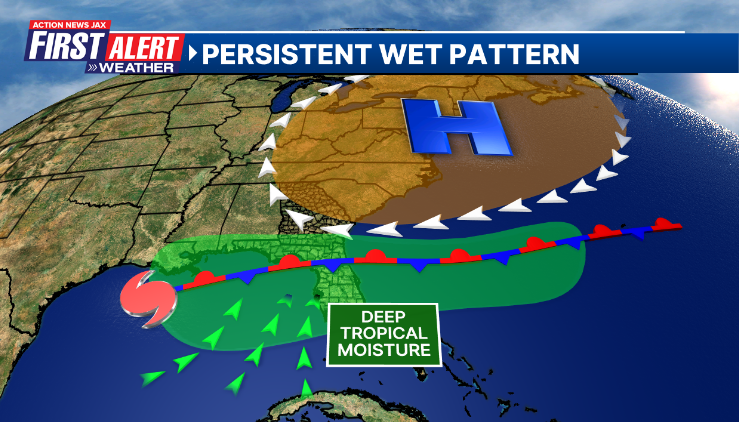JACKSONVILLE, Fla. — First Alert Neighborhood Weather Network. Scan below &/or click * here *:
The latest on the tropics - “Talking the Tropics With Mike” - updated everyday during the hurricane season.
An incredibly wet (& cloudy) stretch from Sept. 3 through Sept. 11 in Jacksonville/NE Fl./SE Ga. (though not unprecedented). More rain fell during a shorter period of time with Irma in 2017, Matthew in 2016 & Fay in 2008 but, of course, those soakers were helped out by the tropical systems. The cause for this month’s local deluge has been a stationary front that is waffling south & north... upper level disturbances riding west to east along the front... & east winds off the Atlantic funneling an endless supply of moisture.
Some local hurricane history: It was 7 years ago when hurricane Irma hit Florida... & 60 years ago when hurricane Dora came ashore in Northeast Florida.
Irma - read a summary in the “Buresh Blog” * here *... first made landfall in the Middle Keys on Sept. 10 & while moving northward brought heavy rain, strong winds & flooding to Northeast Fl. & SE Ga. The result was the greatest flood for downtown Jacksonville since the mid 1800s. The pic below was sent to me from our Action News Jax Digital Content Manager as I took a bit of a break from our continuous on air coverage while Garrett Bedenbaugh takes over on air. The second pic was snapped by Action News Jax sports director Brent Martineau while I tracked Irma in the First Alert Weather Center deep into the night.

:quality(70)/arc-anglerfish-arc2-prod-cmg.s3.amazonaws.com/public/ATPBNPV3BWGJLEXBPCNA7F7GQA.jpg)

Hurricane Dora came ashore shortly after midnight Sept. 10th as a Cat.2 & is the last time the eye of a hurricane crossed the Northeast Florida coastline, a direct landfall in other words. Damage was considerable - see a nostalgic photo gallery from the Florida Times Union * here *. Then President Lyndon B. Johnson visited Jax Beach declaring a national disaster while the Beatles still played that week in downtown Jacksonville.
Night skies from Sky & Telescope:
Sept. 17 (morning): The almost-full Moon is less than 2° below Saturn, and it covers Saturn as seen from western U.S.
Sept. 17 (evening): A short partial lunar eclipse will be visible all across the Americas (midpoint at 10:44 p.m. EDT.)
Sept. 22 (morning): High in the southeast the waning gibbous Moon passes through the Pleiades in Taurus.
Sept. 22: The equinox occurs at 8:44 a.m. EDT. Astronomical autumn begins in the Northern Hemisphere.
Sept. 25 (morning): The waning lunar crescent is 4° upper left of Mars, and they climb higher as the night wears on.
Sept. 26 (dawn): The Moon, still in Gemini, is 1½° below Pollux, the brighter of the Twins’ main stars.
Sept. 29 (dawn): The thin lunar crescent rises in the east-northeast 2½° left of Regulus, Leo’s brightest star.
Moon Phases
First Quarter September 11 2:06 a.m. EDT
Full Moon September 17 10:34 p.m. EDT (Harvest Moon; partial lunar eclipse visible throughout the U.S.)
Last Quarter September 24 2:50 p.m. EDT














